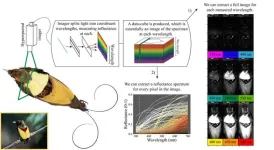(Press-News.org) A new study from UC San Diego’s Comparative Cognition Lab shows that dogs trained to use soundboards to “talk” are capable of making two-word button combinations that go beyond random behavior or simple imitation of their owners. Published in the journal Scientific Reports from Springer Nature, the study analyzed data from 152 dogs over 21 months, capturing more than 260,000 button presses – 195,000 of which were made by the dogs themselves.
“This is the first scientific study to analyze how dogs actually use soundboards,” said lead researcher Federico Rossano, associate professor of cognitive science at UC San Diego and director of the Comparative Cognition Lab. “The findings reveal that dogs are pressing buttons purposefully to express their desires and needs, not just imitating their owners. When dogs combine two buttons, these sequences are not random but instead seem to reflect specific requests.”
The study observed that the buttons most commonly used were related to essential needs, with words such as “outside,” “treat,” “play,” and “potty.” Notably, combinations like “outside” + “potty” or “food” + “water” were used in meaningful ways, occurring more frequently than expected by chance.
For dog owners, this research offers a new way to better understand their pets’ needs. “While dogs already communicate some of these needs,” Rossano said, “soundboards could allow for more precise communication. Instead of barking or scratching at the door, a dog may be able to tell you exactly what it wants, even combining concepts like ‘outside’ and ‘park’ or ‘beach.’ This could improve companionship and strengthen the bond between dogs and their owners.”
Data was collected via the FluentPet mobile app, where owners logged their dogs’ button presses in real time. The research team selected 152 dogs with over 200 logged button presses each to analyze patterns of use. Advanced statistical methods, including computer simulations, were used to determine whether button combinations were random, imitative, or truly intentional. The results showed that multi-button presses occurred in patterns significantly different from random chance, supporting the idea of deliberate communication.
The researchers also compared dogs’ button presses to those of their owners and found that dogs were not simply imitating human behavior. For instance, buttons like “I love you” were far less frequently pressed by dogs than by their people.
While the study provides evidence of intentional two-button combinations, the researchers aim to go further. Future investigations will explore whether dogs can use buttons to refer to the past or future—such as a missing toy—or combine buttons creatively to communicate concepts for which they lack specific words.
“We want to know if dogs can use these soundboards to express ideas beyond their immediate needs, like absent objects, past experiences, or future events,” Rossano said. “If they can, it would drastically change how we think about animal intelligence and communication.”
Rossano’s co-authors on the study are Amalia P. M. Bastos, now at Johns Hopkins University; Zachary N. Houghton, now at UC Davis; and Lucas Naranjo with CleverPet, Inc. Bastos’ work on the study was supported in part by Johns Hopkins’ Provost’s Postdoctoral Fellowship Program. While Bastos and Houghton have previously served as consultants to CleverPet, and Naranjo currently works for the company, which manufactures the FluentPet mobile app and soundboard devices, the research design and analysis were conducted independently.
###
END
Dogs use two-word button combos to communicate
2024-12-09
ELSE PRESS RELEASES FROM THIS DATE:
Researchers use a powerful imaging technique to illuminate the colorful plumage of birds
2024-12-09
Animals showcase a remarkable diversity of colors and patterns, from the shimmery appearance of a peacock’s tail to the distinctive rosettes on a jaguar’s fur. Quantifying animal color has been a longtime goal of evolutionary biologists, who aim to understand how color evolved over time—and the physical and genetic mechanisms involved. Ultimately, studying animal color is important because it can reveal how evolutionary forces, such as natural and sexual selection, favor certain traits over others. However, fully capturing animal color is challenging because researchers must choose between high spatial resolution (as in traditional ...
Jabuticaba peel improves nutritional characteristics of bread
2024-12-09
Researchers at the State University of Campinas (UNICAMP) in São Paulo state, Brazil, have developed a sourdough bread formulation enriched with jabuticaba peel that could be an alternative for people with diabetes and others who need to control blood sugar. An article describing their research and test results is published in the journal Foods.
As noted in the article, the high carbohydrate content of bread can sharply raise blood sugar levels, risking hyperglycemia. Given the high demand for healthier bread, which is widely consumed, artisanal bakers seek to diversify their products with formulations that add nutritional value while involving fermentation ...
Department of Energy announces $36 million for student traineeships
2024-12-09
WASHINGTON, D.C. - Today, the U.S. Department of Energy (DOE) announced 29 projects totaling $36 million to 42 institutions in 16 states for traineeships for undergraduate students, graduate students, and postdoctoral researchers in science, technology, engineering, and mathematics (STEM). The funding, through the DOE Office of Science’s RENEW initiative, will support hands-on research experience, professional development activities to build or reinforce STEM identity, and mentorship to support personal and professional growth of trainees.
“The RENEW program provides new entry points to science for ...
Employee visits to adult or gambling sites doubles risk of infection by malware
2024-12-09
AUSTIN, TX, Dec 9, 2024 – Malware (malicious software) is a worldwide threat to network security for organizations. Individual users within those networks may inadvertently download or interact with malware like viruses and ransomware by browsing unsafe websites, downloading software, or clicking on phishing links in emails.
Cybersecurity researchers from the University of Trento and Vrije Universiteit Amsterdam and the global cybersecurity firm Trend Micro wondered what behaviors bring the greatest risk of malware infection: working at night, browsing adult content, gambling, having a lot of software installed or just visiting strange places?
The ...
Biodiversity at risk in most rainforests
2024-12-09
New research has revealed less than a quarter of the remaining tropical rainforests around the globe can safeguard thousands of threatened species from extinction.
The research, co-authored by The University of Queensland’s Professor James Watson, evaluated the global availability of structurally intact, minimally disturbed tropical rainforests for more than 16,000 species of mammals, birds, reptiles, and amphibians.
“Using remote sensing and forest integrity indicators, we analysed the quality of the rainforests across the ranges of the forest-dependent vertebrates,” Professor Watson said.
“Overall, up to 90 per cent of ...
Climate change impacting freshwater fish species, study finds
2024-12-09
Freshwater fish populations that dwell nearer the poles are outperforming their equatorial counterparts, researchers have found.
Large-bodied migratory species such as Atlantic salmon are thriving as warming temperatures opens up new habitats at the poleward edge of their ranges.
The study, published today in PNAS, was based on a dataset of over 10,000 time series and included over 600 species of fishes.
Climate change has emerged as a key threat to biodiversity, leading to broad-scale shifts in distributions of marine and terrestrial species as they attempt to track thermally suitable habitat. Despite ...
UVM research team unveils breakthrough mechanism in brain blood flow regulation
2024-12-09
Burlington, Vt.— A team of UVM scientists led by Mark Nelson, Ph.D., from the Larner College of Medicine at the University of Vermont, has uncovered a novel mechanism that reshapes our understanding of how blood flow is regulated in the brain. The study, published in The Proceedings of the National Academy of Sciences (PNAS), a peer reviewed journal of the National Academy of Sciences (NAS), introduces Electro-Calcium (E-Ca) Coupling, a process that integrates electrical and calcium signaling in brain capillaries to ensure precise blood flow delivery to active neurons.
In the human body, blood is delivered into the brain from surface arteries ...
How ‘Conan the Bacterium’ withstands extreme radiation
2024-12-09
Dubbed “Conan the Bacterium” for its extraordinary ability to tolerate the harshest of conditions, Deinococcus radiodurans can withstand radiation doses thousands of times higher than what would kill a human — and every other organism for that matter.
The secret behind this impressive resistance is the presence of a collection of simple metabolites, which combine with manganese to form a powerful antioxidant. Now, chemists at Northwestern University and the Uniformed Services University (USU) have discovered how this antioxidant works.
In ...
USC Stem Cell study breaks the silence on how fish and lizards regenerate hearing
2024-12-09
A new USC Stem Cell study published in the Proceedings of the National Academy of Sciences (PNAS) has identified key gene regulators that enable some deafened animals—including fish and lizards—to naturally regenerate their hearing. The findings could guide future efforts to stimulate the regeneration of sensory hearing cells in patients with hearing loss and balance disorders.
Led by first author Tuo Shi and co-corresponding authors Ksenia Gnedeva and Gage Crump at the Keck School of Medicine of USC, the study focuses on two cell types in the inner ear: the sensory cells that detect sound, and the supporting cells that create an environment where ...
Earliest deep-cave ritual compound in Southwest Asia discovered
2024-12-09
CLEVELAND (Dec. 9)—A cave in Galilee, Israel, has yielded evidence for ritualistic gathering 35,000 years ago, the earliest on the Asian continent. Three Israeli researchers led the team that published its results today in the journal Proceedings of the National Academy of Sciences.
And researchers from the Case Western Reserve University (CWRU) School of Dental Medicine helped unearth the cave’s secrets over more than a decade of excavation.
Manot Cave was used for thousands of years as a living space for both Neanderthals ...




